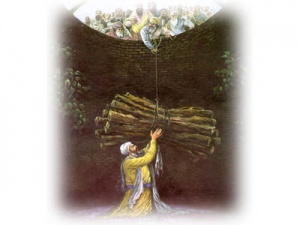Template:Today's featured article: Difference between revisions
No edit summary |
|||
| Line 1: | Line 1: | ||
[[Image: | [[Image:Bhai Manjh.jpg|300px|right|Bhai Manjh, an ardent disciple of the Guru, used to bring dry wood everyday for the langar to be cooked. One day while carrying wood he tumbled into a well following a storm. Guru Arjan Dev found that despite his predicament Bhai Ji had saved the wood from getting wet. The Guru honored his disciple by saying, Manjh is beloved of the Guru and the Guru of the Manjh. Bhai Manjh Singh in the Well sending woods for Guru Ka Langar]] In the time of Guru Arjan Dev jee, there was a powerful and rich Jat by the name of Teeratha. Teeratha was a follower of the Muslim sect of Sakhee Sarvar. He was the local leader of this sect and had hundreds of followers who all respected him. Teeratha would regularly lead the members of this sect on a pilgrimage to the main Sakhee Sarvar shrine now in Pakistan ''' | ||
==== Meeting the Guru ==== | |||
Once when passing through Amritsar, Teeratha decided to visit Guru Arjan. He had heard that there was a great Guru who had a large following and this Guru was spiritually enlightened. He was curious to know who this Guru was and what he would say. He decided to stop off and see the Darbar of Guru Arjan. When he saw the Darbar, he saw that people of many different backgrounds, and castes were all sitting together and living in harmony. He also heard the keertan in the darbaar and the keertan left a permanent mark on him. [[Bhai Manjh|....Continued]]''' | |||
Revision as of 15:44, 11 April 2005
In the time of Guru Arjan Dev jee, there was a powerful and rich Jat by the name of Teeratha. Teeratha was a follower of the Muslim sect of Sakhee Sarvar. He was the local leader of this sect and had hundreds of followers who all respected him. Teeratha would regularly lead the members of this sect on a pilgrimage to the main Sakhee Sarvar shrine now in Pakistan
Meeting the Guru
Once when passing through Amritsar, Teeratha decided to visit Guru Arjan. He had heard that there was a great Guru who had a large following and this Guru was spiritually enlightened. He was curious to know who this Guru was and what he would say. He decided to stop off and see the Darbar of Guru Arjan. When he saw the Darbar, he saw that people of many different backgrounds, and castes were all sitting together and living in harmony. He also heard the keertan in the darbaar and the keertan left a permanent mark on him. ....Continued

